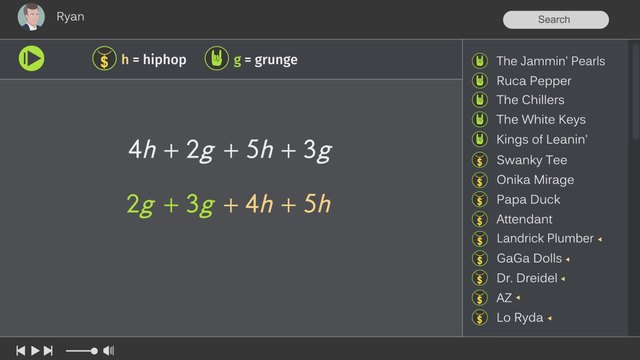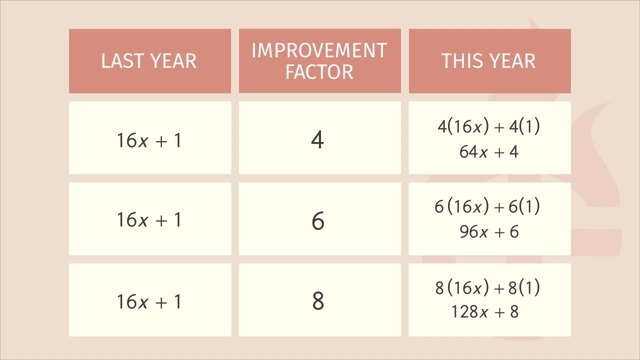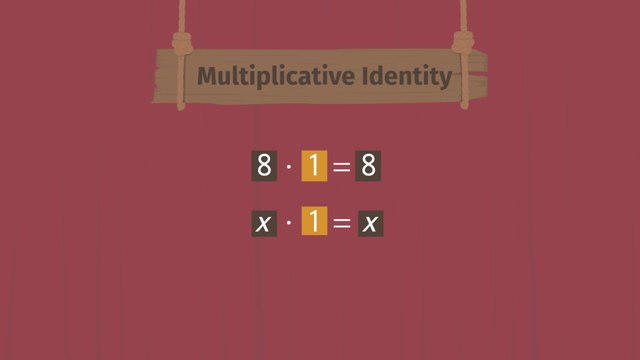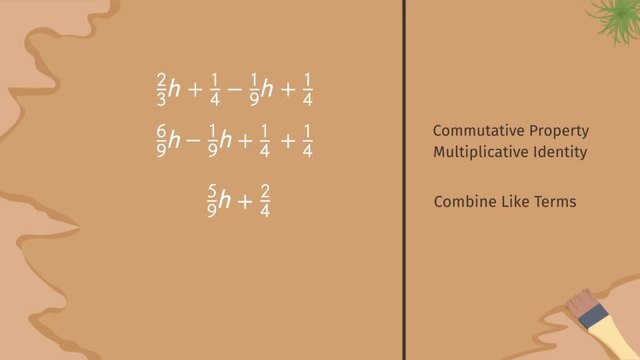Writing Equivalent Algebraic Expressions For Multiplication and Division
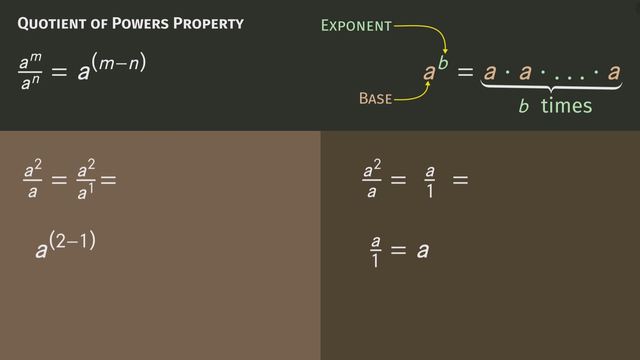

Basics on the topic Writing Equivalent Algebraic Expressions For Multiplication and Division
The quotient of powers property is used for simplifying division problems involving expressions with the same bases raised to exponents. Dividing such expressions is the same as raising the common base to the difference of the exponent of numerator and the exponent of the denominator. This property is the reason why cancellation of common terms found both in the numerator and denominator in rational expressions is possible. Learn about the quotient of powers property by supporting Morton as he tries to defeat Manfred in a friendly competition of stamp collecting. Common Core Reference: CCSS.MATH.CONTENT.8.EE.A.1
Transcript Writing Equivalent Algebraic Expressions For Multiplication and Division
It’s Saturday night and Morton waits for his friend and competitor, Manfred, to join him in his mom's basement. Manfred shows up to once and for all settle their lifetime-long competition in the royal and most honorable discipline of... Stamp collecting! How do you compete at stamp collecting? The collector with the most precious stamps wins. First, they reorder their collection. Then, they cancel out like-stamps. Reordering and canceling out like stamps is similar to a math property we can use when using the Quotient of Powers Property. Let's see how they do that with their stamp collections. Each angelfish stamp is represented with the letter ‘a’. For a barracuda stamp, we use the letter ‘b'. And, for a conch stamp, we use the letter ‘c’. See how like-variables cancel each other out? To apply the Quotient of Powers Property for like bases, the base stays the same and simply subtract the exponent in the denominator from the exponent in the numerator. Remember, this only works for like-bases. Bases are the number or variable that is multiplied by itself and the exponent is the smaller number above that tells us how many times to multiply the base by itself. Any base raised to the 1st power is equal to the base. Let's try this problem. Just like we did with the stamps, we can cancel out the like-variables. The simplified expression is equal to 'a'. Now let’s use the Quotient of Powers Property to simplify the same expression. For like-base 'a', we can subtract the exponent in the denominator from the exponent in the numerator, so 'a' is raised to the '2 minus 1' power, which is equal to 'a' raised to the first power, or just 'a'. Let’s use the Quotient of Powers Property to simplify another expression. First, let’s write this expression as a fraction. Remember, the fraction bar is another math symbol that indicates division. To make it easier to solve, let’s reorder the equation to put like-parts together. Then, for the like-bases, subtract the exponent in the denominator from the exponent in the numerator. Let's do one more problem. Oh, this problem looks very complicated. Naah, we can do it! Just use your math rules and properties! First, remember that when dividing by a fraction, just multiply by the reciprocal. Remember, to find the reciprocal of a fraction, just switch the position of the numerator and denominator. First, multiply the two numerators and the two denominators together. Next, rewrite the equation to separate the numerator and denominator into fractions with like-terms. Coefficients with coefficients, x's with 'x's, and 'y's with 'y's, and finally, apply the Quotient of Powers Property. Let's get back to Morton and Manfred and the duel of the stamps. The stamp competition is going down to the wire and Morten has a surprise move. He breaks out his most precious stamp: the red lobster. Oh no!
Writing Equivalent Algebraic Expressions For Multiplication and Division exercise
-
Explain how to use the quotient of powers property for like bases.
HintsKeep the following powers in mind
- $a^1=a$
- $a^0=1$ for $a\neq 0$
Keep the order of subtraction in mind:
$\frac{a^4}{a^2}=\frac{a\cdot a\cdot \not a\cdot \not a}{\not a\cdot \not a}=\frac{a^2}1=a^2$
Remember the fraction notation:
$\frac{\text{numerator}}{\text{denominator}}$
Remember that negative just means opposite. So if an exponent is positive we already know that means how many times we multiply the number. Therefore, a negative exponent means how many times to divide by the number.
For example $c^{-2} = \frac{1}{c \cdot c}=\frac{1}{c^2}$
SolutionFirst, let's have a look at the left stamps with the letter $a$. The corresponding expression is
$\frac{a^3}{a^3}=\frac{\not a\cdot \not a\cdot \not a}{\not a\cdot \not a\cdot \not a}=\frac 11=1$
How can we generalize this? You see the like basis $a$. You can cancel out as many factors as the highest in the numerator as well as the denominator:
$\frac{a^3}{a^3}=a^{3-3}=a^0=1$
Wow, that's it. You just have to subtract the exponent in the denominator from this one in the numerator. The base stays the same.
It is helpful to memorize that: $a^n$ is called a power, where $a$ is the base and $n$ the exponent.
Let's try it one more time:
$\frac{b^2}{b}=\frac{b\cdot \not b}{\not b}=b^1=b$
Does this also work with the property above?
$\frac{b^2}{b}=b^{2-1}=b^1=b$
Yes! This property is called the quotient of powers property and works when the bases are the same
$\frac{a^m}{a^n}=a^{m-n}$
Just keep in mind that order matters with subtraction.
Last we check if this property also works if the exponent in the denominator is greater than this one in the numerator:
$\frac{c^4}{c^5}=\frac{\not c\cdot \not c\cdot \not c\cdot \not c}{\not c\cdot \not c\cdot \not c\cdot \not c\cdot \not c}=\frac 1{c}$
Now we use the quotient of powers property
$\frac{c^4}{c^5}=c^{4-5}=c^{-1}=\frac1c$ $~~~~~$✓
-
Simplify the expressions using the quotient of powers property.
HintsHere you see the quotient of powers property for like bases.
Be careful to subtract the exponent in the denominator from the one in the numerator and not the other way round.
Here is an example of the quotient of powers property.
SolutionLet's practice the quotient of powers property with a few examples:
$\mathbf{\frac{a^2}a}$
We just have to subtract the exponents: this one in the denominator from this one in the numerator to get
$\frac{a^2}{a}=a^{2-1}=a^1=a$
$\mathbf{27a^2b^3\div(9ab^2)=\frac{27a^2b^3}{9ab^2}}$
Remember: The fraction bar is just another way to write down a division.
We first rearrange this term to get only fractions of like terms:
$\frac{27a^2b^3}{9ab^2}=\frac{27}9\cdot\frac{a^2}{a}\cdot\frac{b^3}{b^2}$
Now we simplify each fraction step by step
- $\frac{27}9=3$
- $\frac{a^2}{a}=a^{2-1}=a^1=a$
- $\frac{b^3}{b^2}=b^{3-2}=b^1=b$
$\frac{27a^2b^3}{9ab^2}=3ab$
$\mathbf{18x^5\div\frac{6x^3y^2}{y^3}=\frac{18x^5}{1}\cdot\frac{y^3}{6x^3y^2}}$
Once again we rearrange the terms
$\frac{18x^5}{1}\cdot\frac{y^3}{6x^3y^2}=\frac{18}{6}\cdot\frac{x^5}{x^3}\cdot\frac{y^3}{y^2}$
Now we are in the position to use the quotient of powers property for like basis
- $\frac{18}6=3$
- $\frac{x^5}{x^3}=x^{5-3}=x^2$
- $\frac{y^3}{y^2}=y^{3-2}=y^1=y$
$18x^5\div\frac{6x^3y^2}{y^3}=3x^2y$
-
Determine the value of each expression.
HintsFirst, use the quotient of powers property for like basis.
Remember the exponents mean multiplication by itself that many times. For example, $6^2 = 6 \cdot 6 = 36$.
The smallest result is $8$ and the largest one $27$.
SolutionHere you see the expressions in the right order. Each time we use the quotient of powers properties for like terms.
- $\frac{2^5}{2^2}=2^{5-2}=2^3=8$
- $\frac{3^6}{3^4}=3^{6-4}=3^2=9$
- $\frac{4^7}{4^5}=4^{7-5}=4^2=16$
- $\frac{5^5}{5^3}=5^{5-3}=5^2=25$
- $\frac{3^5}{3^2}=3^{5-2}=3^3=27$
-
Find the equivalent expressions.
HintsInstead of dividing by a fraction you can multiply with the reciprocal of the fraction.
Rearrange the fraction thus that you can use the quotient of powers property.
SolutionTo use the quotient of powers property for like bases, we should first have to deal with what we already know about fractions. In the first problem that would be dividing by a fraction is the same as multiplying by its reciprocal.
$\frac{21x^2y^3}{7xy^3}$
- $\frac{21x^2y^3}{7xy^3}=\frac{21}{7}\cdot\frac{x^2}{x}\cdot\frac{y^3}{y^3}$
- $\frac{21}7=3$
- Now we use the quotient of powers property:
- $\frac{x^2}{x}=x^{2-1}=x^1=x$
- $\frac{y^3}{y^3}=y^{3-3}=y^{0}=1$
$\frac{21x^2y^3}{7xy^3}=3x$
$\frac{x^2y^2}{5}\div\frac{x^2y}{25}=\frac{x^2y^2}{5}\cdot\frac{25}{x^2y}$
- $\frac{25}5=5$
- $\frac{x^2}{x^2}=x^{2-2}=x^0=1$
- $\frac{y^2}{y}=y^{2-1}=y^{1}=y$
$\frac{x^2y^2}{5}\div\frac{x^2y}{25}=5y$
$\frac{10x^3y^2}{2xy^2}$
- $\frac{10}2=5$
- $\frac{x^3}{x}=x^{3-1}=x^2$
- $\frac{y^2}{y^2}=y^{2-2}=y^0=1$
$\frac{1}{15xy}\div\frac{x^2}{75xy^2}$
Once again we multiply with the reciprocal
$\frac{1}{15xy}\div\frac{x^2}{75xy^2}=\frac{1}{15xy}\cdot\frac{75xy^2}{x^2}$
and simplify first
$\frac{y^2}{15x}\cdot\frac{75x^2}{y}=\frac{75x^2y^2}{15xy}$
- $\frac{75}{15}=5$
- $\frac{x^2}{x}=x^{2-1}=x^{1}=x$
- $\frac{y^2}{y}=y^{2-1}=y^1=y$
$\frac{y^2}{15x}\cdot\frac{75x^2}{y}=5xy$
-
Complete the equations.
HintsKeep $a^1=a$ in mind.
Pay attention to the order of subtraction.
Using this given example you can see that given factors cancel out.
SolutionYou can determine the quotient of powers with like bases canceling as many factors as possible or using the quotient of powers property.
The result is always the same.
Canceling
$\frac{a^2}a=\frac{a\cdot \not a}{\not a}=\frac{a}1=a$
The quotient of powers property
$\frac{a^2}a=a^{2-1}=a^1=a$ $~~~~$✓
-
Rewrite the expressions in their simplest form.
HintsKeep the following equations in mind:
- $a^1=a$
- $a^0=1$
Use the quotient of powers property for like bases.
Dividing by a fraction is the same as multiplying by its reciprocal.
Solution$\mathbf{\frac{2^6 a^7}{b^5}\cdot\frac{b^{10}}{2^4a^4}}$
We handle each base as its own in alphabetical order:
- $\frac{2^6}{2^4}=2^{6-4}=2^2=4$
- $\frac{a^7}{a^4}=a^{7-4}=a^3$
- $\frac{b^{10}}{b^5}=b^{10-5}=b^5$
$\mathbf{\frac{33 x^4y^2}{x}\div\frac{11}{y^2}}$
First, we multiply with the reciprocal of the second fraction
$\frac{33 x^4y^2}{x}\div\frac{11}{y^2}=\frac{33 x^4y^2}{x}\cdot\frac{y^2}{11}$
- $\frac{33}{11}=3$
- $\frac{x^4}{x}=x^{4-1}=x^3$
- $\frac{y^2}{y^2}=y^{2-2}=y^0=1$
$\mathbf{\frac{3^4}{b^2}\cdot\frac{a^6b^5}{3 a^4}}$
Here we have to use the quotient of powers property three times:
- $\frac{3^4}{3}=3^{4-1}=3^3=27$
- $\frac{a^6}{a^4}=a^{6-4}=a^2$
- $\frac{b^5}{b^2}=b^{5-2}=b^3$
Last let's do the following task
$\mathbf{25x^2y^3\div\left(5^2xy\right)}$
The fraction bar is just another to write down a division exercise:
$25x^2y^3\div\left(5^2xy\right)=\frac{25x^2y^3}{5^2xy}$
- $\frac{25}{5^2}=5^{2-2}=5^0=1$
- $\frac{x^2}x=x^{2-1}=x$
- $\frac{y^3}{y}=y^{3-1}=y^2$


